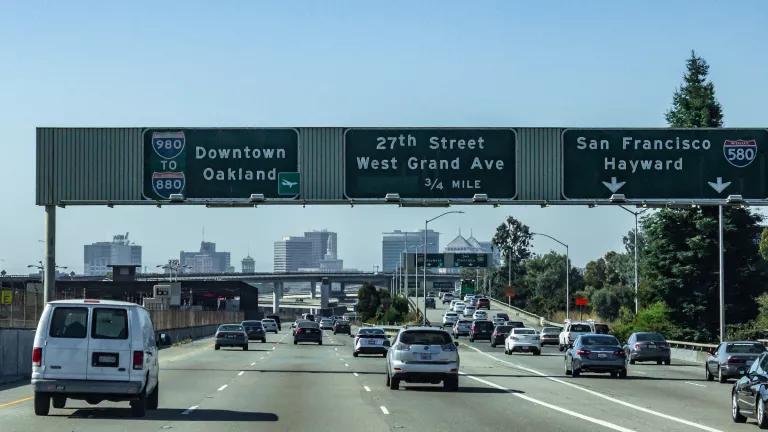The Legal Battle to Preserve the Advanced Clean Fleets Rule
California's Advanced Clean Fleets Rule faces legal opposition, threatening billions in health and economic benefits.

Electric truck stop in Otay Mesa, San Diego
California Energy Commission
California's Advanced Clean Fleets (ACF) rule combats toxic freight pollution in the state. Driven by decades of advocacy from frontline communities, the rule accelerates the deployment of zero-emission trucks, yielding an estimated $26.5 billion in public health benefits and $48 billion in reduced costs for California fleets. But the California Trucking Association has sued in federal court to block implementation of ACF, threatening to deny Californians and fleet operators those staggering public health and economic benefits. Let's delve into why the ACF rule is essential and why the trucking association’s arguments don’t hold up.
The ACF Rule: A Vital Step Towards Sustainability
The ACF rule, with its four key provisions, is designed to propel the adoption of zero-emission vehicles (ZEVs) in the trucking industry. The ACF Rule has four main components that apply to fleets operating in California:
- Drayage Truck Requirements: Starting from January 1st, 2024, only zero-emission drayage trucks -- generally diesel-fueled, heavy-duty tractors that move containers and bulk freight between ports, rail facilities, and distribution centers – can be added to California's fleet. Older drayage trucks must retire at the end of their useful life, aligning with the goal of making all drayage trucks zero-emission by 2035.
- State and Local Fleet Requirements: By 2024, 50 percent of new truck purchases by local governments or the state government must be zero-emission, and by 2027, all of those new truck purchases must be zero-emission.
- "High-Priority" and Federal Fleets Requirements: Fleets meeting certain criteria must comply with either the Model Year Schedule or the Zero-Emission Vehicle Milestones Option.
- Model Year Schedule: Beginning in 2024, fleets must purchase only zero-emission vehicles and starting January 1st, 2025, must remove internal combustion engine vehicles at the end of a useful life period of 18 years.
- Zero-Emission Milestones Option: Fleets may choose to meet zero-emission vehicle targets as a percentage of their total fleet, starting with vehicles that are the most suited for electrification.
| ZEV Fleet Percentage | 10% | 25% | 50% | 75% | 100% |
|---|---|---|---|---|---|
| Box trucks, vans, 2-axle buses, yard trucks, light-duty package delivery vehicles | 2025 | 2028 | 2031 | 2033 | 2035 and beyond |
| Work trucks, day cab tractors, 3-axle buses | 2027 | 2030 | 2033 | 2036 | 2039 and beyond |
| Sleeper cab tractors and specialty vehicles | 2030 | 2033 | 2036 | 2039 | 2042 and beyond |
- Zero-Emission Vehicle Manufacture Sales Requirement: By 2036, all new commercial truck sales in the state must be zero-emission.
To achieve long-term objectives related to air quality, climate, and public health, the transition to commercially available zero-emission technologies is imperative. The ACF rule complements CARB's Advanced Clean Trucks regulation, fostering the adoption of ZEVs in the state's truck and bus fleets.
Environmental and Economic Advantages
The ACF Rule, from 2024 to 2050, is expected to produce health benefits such as avoided deaths, hospital admissions, and emergency room visits, translating to $26.5 billion in statewide health benefits. Additionally, the rules are anticipated to stimulate the economy by bringing net cost savings of $48 billion to fleets, with zero-emission vehicle models increasing significantly. In fact, the rule is projected to introduce 1,690,000 ZEVs into the California fleet by 2050. By focusing first on drayage trucks that travel in and through neighborhoods near seaports, warehouses, and distribution centers, the ACF rule also aims to alleviate the disproportionate impact of harmful truck emissions on local communities.
By transitioning the new truck market to EVs, by 2035, nearly half of all semi-trucks on California highways are expected to be zero-emission, rising to approximately 70 percent by 2042. This promises not only a reduction in emissions but also a significant decrease in disruptive noise, creating a healthier and more sustainable environment for Californians.
The Lawsuits
Currently, the ACF is facing three lawsuits— two in California state court and one in federal court. The state court cases primarily involve procedural matters, potentially causing delays but not completely putting a halt to the ACF. In the federal case, there’s a preemption claim under the fleet provisions of the Clean Air Act and a claim under a federal statute that prohibits local government from regulating the prices, routes or services of interstate trucking, along with a few other claims that are either premature or the legal equivalent of a Hail Mary pass.
The fleet sections of the Clean Air Act regulate what provisions about centrally-fueled truck fleets need to go into the formal air quality plan that some states (including California) need to submit to the Environmental Protection Agency; they do not allow a trucking company to sue a state. And the prices, routes and services provision of federal law has nothing to do with whether a truck is zero-emission or not. A trucking company with a zero-emission truck is free to choose whatever prices, routes, or services it wants, the same as though it were running a diesel truck.
The Need For A Collaborative Approach
While the ACF rule will have a significant impact on the trucking industry, it's important to recognize the progress being made to transition to ZEVs. California surpassed its zero-emission vehicle truck sales goal two years ahead of schedule. The state has distributed more than $780 million to help fleet operators purchase ZEV trucks; the $54 billion Climate Commitment includes over $10 billion to accelerate the ZEV transition and build charging infrastructure. Key federal incentives are also building the foundation of the zero-emission vehicle market. The Inflation Reduction Act contains tax credits of up to $7,500 for light- and medium-duty vehicles and up to $40,000 for heavy-duty trucks. Additionally, the federal tax credit on charging equipment has been extended through 2032. For individual/residential uses, the tax credit remains unchanged at 30 percent, up to $1,000. For commercial uses, the tax credit is 6 percent with a maximum credit of $100,000 per unit (up from $30,000 per property).
Rather than trying to impede progress with unnecessary lawsuits, the trucking industry can play a pivotal role in shaping this transition. The expansion of the charging network for ZEVs addresses concerns about long-haul and heavy-duty applications, ensuring a reliable infrastructure for trucking companies. Additionally, the trucking industry is dependent on diesel fuel – and diesel is expensive and polluting. Electrifying trucks presents a compelling solution to these challenges— with fewer moving parts, they require less maintenance, and the lower cost of electricity means that operators can realize substantial savings.
Moreover, the global trend toward vehicle electrification underscores the need for the trucking industry to stay ahead of evolving technology. Embracing ZEVs not only aligns with global standards but also positions the industry as a leader in innovation and environmental responsibility.
Pave the Way
California's Advanced Clean Fleets rule demonstrates the state’s commitment to public health, environmental sustainability, and economic progress. By curbing freight pollution and promoting zero-emission technologies, California aims to create a healthier and cleaner future for its residents. The legal challenge posed by the CTA and others should not overshadow the undeniable benefits of transitioning to zero-emission technologies. It's time for stakeholders to come together, engage in constructive dialogue, and collectively pave the way for a transportation industry that is not only economically viable but also environmentally responsible.



